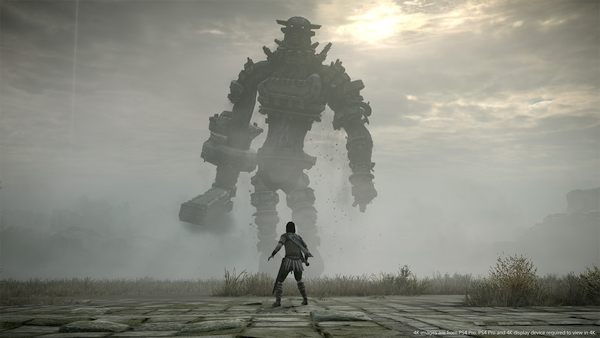
Sony and Bluepoint Games repackaged Shadow of the Colossus and Ico in an HD Collection bundle for the PS3 in 2011. In addition to promoting the latter with the proper boxart for the first time in North America, the re-release gave PS3 owners a new opportunity to return to the worlds of Fumito Ueda. But with the PS4’s launch looming, Sony had even bigger plans for Shadow of the Colossus, and they wanted to take the famously frustrating game in a brand new direction.
 Insert Quarter is a glimpse into gaming’s past, present, and future through an exploration of historical, retrospective, and contemporary reporting.
Insert Quarter is a glimpse into gaming’s past, present, and future through an exploration of historical, retrospective, and contemporary reporting.
As the team responsible for the God of War Collection, Uncharted: The Nathan Drake Collection, and Gravity Rush Remastered, Bluepoint has earned a reputation as masters of the remaster. Traditionally, their goal is to create a game that hues as closely to the original as possible while also offering the high definition visuals that today’s players expect. But with Shadow of the Colossus, Bluepoint revisited their earlier remaster and attempted to rebuild it “from the ground up” as an entirely new experience.
Ben Lindbergh explored the mechanics of Bluepoint’s process in an article for The Ringer:
A remake like the new Shadow relies less on recycled assets than the remasters did; it’s the difference between trying to fine-tune a fainter, scratchier recording of a symphony and hiring a bigger, better orchestra to rerecord it with more sensitive mics. To harness the PS4’s power, Bluepoint broke down the old Shadow’s bones and built them back up again. “The original world exists in kind of a skeleton format for us to then go back and start plugging in assets and… really just fleshing out the world to the point where what you’ve seen on screen now is something that represents a current-gen title,” Lowe says. “From that aspect, that’s completely ground up. The Colossi, the characters—we looked at the originals and said, ‘Here’s our guideline, now go build it fresh.’ And that process was repeated throughout the game for every asset.”
Meet the Masters of Video Game Remasters
But in updating Shadow of the Colossus for modern hardware, Bluepoint pushed up hard against the dreamlike qualities that made the game so memorable in the first place. In a piece for Eurogamer, Gareth Damian Martin argued that the developer’s devotion to realism has robbed the game of some of its spirit:
It’s a question of fidelity, a word that is linked more to image than it is to space. We often use that word to describe game worlds, and their startling reproduction of the detail and depth of real spaces and landscapes. When I looked at the remake of Shadow of the Colossus, fidelity is what I saw. What was once an expressionistic, flat shaded block of grey in the original game, a suggestion of a cliffside, became a description of a cliffside, with each of its multitude of cracks and stains, splits and colours evident to my eyes. In the remake this level of fidelity betrays its split attitude. After all, fidelity is a word that refers to recreation, exactitude, and in its original meaning, faithfulness. But this remake isn’t faithful to the original alone, but to reality too. When we talk about its fidelity, we aren’t just talking about a faithful recreation of the qualities of the original game, we are also talking about a reproduction of the images that the original game itself was derived from.
The question of fidelity and Shadow of the Colossus
Clayton Purdom of The AV Club somewhat agreed with this assessment in his own examination of the remake, but he also believes that preservation of classic games is necessary, and a more modern technical presentation can make that more palatable to gamers as long as the original aesthetics are honored:
And so I reacted to the idea of a full-scale remake of his second game, Shadow Of The Colossus, with a certain amount of disdain after it was announced with a recreation of the game’s opening cut scene. The causes for concern were many—chief among them, visual. The game is known for its barren setting, and the muted, blurry hues of the PlayStation 2 were perfect for drawing these vast abysses, traveled over by only you, a lonely wanderer named Wander; your faithful horse; and the occasional skittering lizard. The colossi that slumbered among these gray ruins burst to life, like the landscape itself rumbling into sentience. The notion that someone was going to saunter back through this world and render it “realistic” or more palatable to modern players felt like mixing Phil Spector out of mono or dropping CGI monsters into Mos Eisley.
The Shadow Of The Colossus remake is heresy—and it’s also essential
If you’ve never played Shadow of the Colossus, you might be drawn to the PS4 remake because it’s so much simpler to jump into the game using a modern console hooked up to a modern television. Buying a new game for the PS4 in 2018 is an easier option versus tracking down a (possibly damaged) used copy for the PS2, and then wrestling with the grainy visuals you get from merging composite cables with a high definition display.

But Steven T. Wright of The Outline believes that either version of Shadow of the Colossus will suffice, because its defining contribution to gaming isn’t as a shorthand for “game with big boss fights,” but that it was the first (and probably only) open-world that was completely empty:
When it comes to the colossi themselves, they must use Wander’s ancient sword to reflect sunbeams that coalesce in the general direction of their quarry — a less-than-perfect indicator, especially when it points directly at a sheer cliff-face. But most damning of all, besides tracking down the next colossi, there’s almost no incentive for the player to roam around beyond the main trails, no treasure lurking on the edge of the map, no wayward non-player characters to pledge your allegiance to. In a gaming universe now conquered by the thrall of the open-world, Shadow has the gall to offer something distinct: an empty-world game.
The wonderfully empty world of Shadow of the Colossus
Whichever version of the game you choose, the one constant is that the massive Colossi will always tower over the Forgotten Land, and the low-slung camera only magnifies their dominance.
But it’s likely that many developers have the same feelings about Shadow of the Colossus itself. Fumito Ueda’s masterpiece is always towering over the gaming landscape, and it completely changed the way we talk about games.
